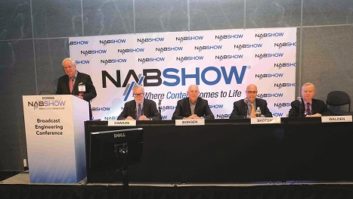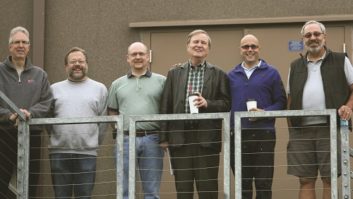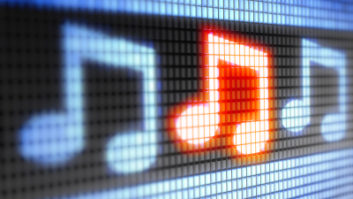Ibiquity Digital Corp. is trying to quantify the interference that exists for AMs at night and what changes might occur with IBOC.
For several reasons, the effort is limited compared to previous testing; but observers for Ibiquity and the National Radio System Committee believe any effort to quantify AM IBOC interference at night is helpful. The testing was to begin in late August, with results to be publicized later.
At the same time, observers looked to the FCC to issue some type of initial blessing of IBOC. They want the FCC to make clear that other solutions, involving Eureka-147, TV Channel 6 or other approaches, won’t be used.
Supporters also have pressed the FCC to allow stations that want to transition this fall to do so, possibly using a blanket special temporary authorization.
The FCC does not comment on its plans. The agency has a team working on IBOC, according to sources.
“We recognize their anxiousness and we will do everything we can to move quickly,” said a source close to the agency. But he said comments to the FCC reveal differences of opinion that must be worked out before commissioners can sign off.
“This is not instant oatmeal,” the source said.
A major issue for AM is the power level stations would use when they sign on with IBOC. Clear Channel has suggested, and ABC agreed, that AMs should lower their power levels initially by 6 dB, so the primary digital carriers are 22 dB below the main carrier, as opposed to Ibiquity’s proposed 16 dB. The goal: to reduce the possibility of interference to adjacent stations.
Other groups that lack higher-power AMs operating on skywaves at night oppose the idea, saying lower power effectively would cut their coverage area in half. They also worry that it may be difficult to recover full power later.
Also confronting the FCC is the fact that the NRSC has so far endorsed AM IBOC only for daytime.
“This AM thing is tough enough without making it worse. Now we’re saying we’re daytime-only and cutting power? That won’t cut it for most (AM) stations,” said one major group engineer.
Another issue for the FCC is whether to delay implementation of IBOC entirely until the AM issue is settled, as some commenters suggest. Proponents say they’d lose momentum for receiver manufacturers to produce radios.
Some sources say a conservative course for the FCC would be to approve AM IBOC for daytime use at full power, with a caveat that an interfering station must reduce power or stop transmitting digital altogether.
As Labor Day approached, observers were hoping the commission would act at a public meeting slated for Sept. 12.
Meanwhile, Ibiquity planned to use computer modeling to determine existing interference for every AM station in the country and project potential effects of IBOC.
“It’s a sophisticated study, more so than what has been done before in terms of propagation,” said Ibiquity Vice President for Engineering Glynn Walden. The tests are expected to take a couple of months and include subjective listening.
Testing in the field for AM at night is difficult because the atmosphere changes constantly. NAB Science and Technology Vice President John Marino heads up an ad hoc group of NAB and NRSC engineers advising Ibiquity on the nighttime tests. “In order to do a scientific study, (it) would take a long time, perhaps years, depending on the sun spot cycle.”
Ibiquity is using WLW(AM) in Cincinnati for skywave tests. “We’ll have a digital signal on WLW and study the impact of WLW on other stations,” said Ibiquity Vice President and General Counsel Al Shuldiner.
“For WLW, we’ll look at existing groundwave analog reception with IBOC off. Then, we’ll turn it on and see if that changed the groundwave signal. Then we’ll go to another point in the country and measure skywave reception, with the IBOC on and then off, to determine changes.”
Ibiquity planned to use WTOP(AM) in Washington to test the impact of a digital signal on local stations at night.
Shuldiner said the goal is to quantify any impact on existing stations from the digital signal. The NRSC has stated that IBOC will entail certain tradeoffs, such as accepting some interference in some outside metro coverage areas.
All sources contacted by Radio World agreed that AM nighttime tests on only two stations are limited; Ibiquity has cited its time constraints as the reason it cannot do more at this time. One group engineer said testing on only two stations is not sufficient, “not to the point where we’ll hang our (hat) on this for the rest of our lives.”
“We need to evaluate as broadcasters if the (50 kW) clear-channel stations have as much value as their owners think they do,” he said. “There may have to be tradeoffs to make sure AM survives.”
Ibiquity is using other stations, such as WOR(AM) in New York, to demo its service for receiver makers. It also has applied for STAs to demo IBOC in Seattle during the Radio Show on Infinity’s KBKS(FM) and Sandusky’s KIXI(AM).
Still unclear is whether any radio groups have agreed to transition their stations this fall and whether any had signed Ibiquity’s fee contracts.
Ibiquity said it was negotiating with a number of groups but said discussions were private. Asked for a list of rollout stations, Ibiquity declined.
“In some cases, they’re forming (rollout) strategy and they may not want us to say how’re they’re doing this,” said Ibiquity Vice President Jeffrey Jury.









